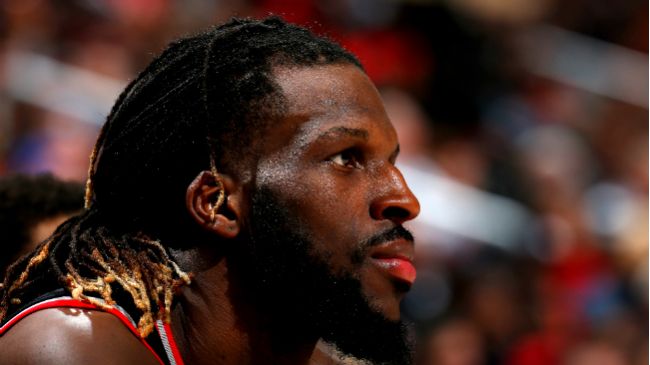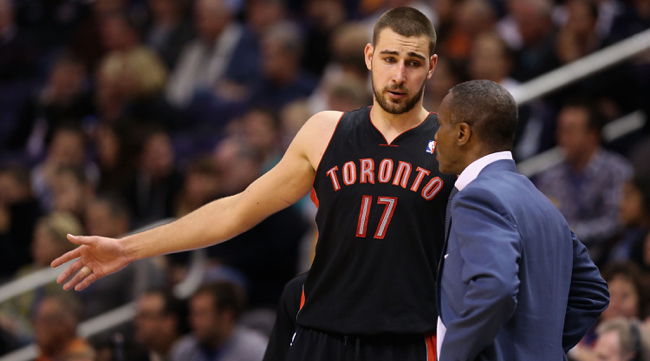The Toronto Raptors were riding a franchise-best 11-game winning streak going into Monday night’s matchup against the Denver Nuggets. They proceeded to inexplicably get blown out 112-93, mere hours after Dwane Casey was named Eastern Conference Coach of the Month for January. Okay, so maybe it wasn’t so inexplicable. After all, the dreaded altitude is always an easy culprit at the Pepsi Center. Either way, they came one game shy of setting the record for the longest winning streak in Toronto sports history.
That’s a pretty impressive accomplishment, especially for the NBA’s lone Canadian team, which has consistently under-performed in the playoffs over the last couple of years, despite home-court advantage in the first round. They’re hoping to shed that label here in 2016, especially considering how things ground to a halt after the All-Star break last season. Make no mistake, the Raptors were a good team in 2014-2015. They won a franchise-record 49 games and clinched the fourth seed in the Eastern Conference.
But they went 13-29 after the All-Star game and were shockingly swept right out of the playoffs in the first round by the Washington Wizards. Some of that, to be fair, had to do with Kyle Lowry‘s nagging back problems (which if you’ve ever had back issues, you know how excruciating it can be just to move, let alone run around and play basketball).
Some of it also had to do with the Raptors’ style of play, which is emphatically out of vogue in the pace-and-space era. Percentage-wise, Toronto is a top 10 three-point shooting team (36 percent), but they’re only middle-of-the-pack in terms of their attempts per game. Part of this has to do with the fact that they average fewer assists per game than every team but the Los Angeles Lakers. That’s not a good sign any way you look at it.
A lot of that begins and ends with their co-Players of the Month for January, Lowry and DeMar DeRozan, who indulge in a troubling amount of ball-pounding, isolation basketball. The fact that they’re near the bottom of the league in terms of pace (25th) is either a byproduct of this iso-heavy ball or a symptom of Casey’s stagnate offensive schemes. It’s a red flag either way.
DeRozan, in particular, is a relic in the modern era due to his affinity for one-on-one play. According to John Schuhmann of NBA.com, DeRozan has taken more contested jump shots than anyone else in the league except for Kobe Bryant (among those who’ve attempted at least 200 shots). But in his defense, he’s been getting into the paint – and as a result to the free-throw line – much more often this season, which has caused a spike in his true shooting percentage and therefore his overall efficiency. In fact, he’s the second-best player in the entire NBA at drawing fouls behind only James Harden. But in the playoffs, when the overall intensity gets ratcheted up to 11, DeRozan is going to have a rude awakening on two fronts: a lot of those driving lanes will be closed off, and he isn’t going to get nearly as a many calls — especially late in games when the “verticality” rule is actually followed.
DeRozan, despite his many skills, is one of the main reasons the Raptors can’t fully conform to the new NBA. An inability to shoot from outside is one thing (31 percent this season from three, which is a career high), but when you compound that with being a high-usage ball-stopper (nearly 30 percent of his team’s possessions), you get an offense that isn’t very agile. He isn’t much help on the other end, either. He’s a minus defender and barely breaks even in terms of net real plus-minus, which doesn’t even rank in the top 10 among shooting guards in the NBA.
Lowry, as the point guard, is supposed to mitigate some of this by probing the defense, causing breakdowns, and creating open looks for teammates. And while he does that to a certain degree, the vast majority of his passes (32 percent) go directly to DeRozan. Conclusion: They’re playing a two-man game out there most of the time.
But unlike DeRozan, Lowry has done his best to assimilate to league-wide trends. Most of his shots come at the rim, where he makes a reasonable percentage (55 percent). His second-most shots come from downtown, where he shoots it at a nearly 41-percent clip. He’s one of Toronto’s few reliable threats from long-range, and the other has been struggling through injuries for most of the season.

Like the Los Angeles Clippers with the ongoing Blake Griffin saga, the Raptors embarked on their historic winning streak without one of their key players in tow. DeMarre Carroll has been out since undergoing arthroscopic knee surgery on Jan. 6 and was expected to miss 6-8 weeks, which means Toronto could be without his services for another month (or longer).
They’ve weathered the storm admirably in his absence, but they’ll desperately need Carroll’s defense, 3-point shooting, and ability to match up as a power forward against smaller lineups if they hope to make an extended postseason run. And in a hypothetical Eastern Conference Finals showdown with the Cleveland Cavaliers that would likely be the result of securing the second seed in the East, Carroll will have the unenviable task of playing foil to LeBron James.
Speaking of defense, here’s where things start to get even more complicated. On paper, the Raptors boast a top-ten defensive rating, but that doesn’t tell the whole story. Lowry, who is second in the league in steals, is also top 10 in RPM, so he’s a net positive on that end.
But where the Raptors really struggle is defending the rim, a problem that begins with enigmatic big man Jonas Valanciunas. Opponents shoot an unforgivable 59 percent against him at the rim, which is a big reason why Casey limits his playing time to around 25 minutes per game. He just can’t afford to have the lumbering seven-footer out there for much longer. Lineups that include Valanciunas at the five are regularly in the red in terms of net rating.
Luis Scola is a crafty, energetic veteran who can make life difficult for anyone who’s guarding him, but like Valanciunas, he’s not a good defender in the paint. He’s also a mediocre rebounder and barely breaks even in terms of his net rating.
Which brings us to one of Toronto’s biggest saving graces: their second unit. Their bench as a whole isn’t really anything to write home about. Their overall production ranks them in the middle of the pack in the NBA, but that again doesn’t tell the whole story. The configuration that includes Corey Joseph, Bismack Biyombo, Terrance Ross and Patrick Patterson (along with Lowry) sends their net rating rocketing into outer space. It’s no wonder that quintet is Casey’s third most-used lineup.
A lot of that success has to do with Biyombo being a much better defender in the paint. Joseph is a pretty terrible 3-point shooter, but like Lowry, he’s a solid finisher around the rim, which is where he takes the majority of his shots. Again, that should ostensibly open up opportunities for teammates, such as Ross, who’s solid shooter from distance at 38 percent but certainly qualifies as streaky, too.
Without a doubt, that second unit gives Toronto a much-needed jolt of electricity, but it’s hard to see them being much of a difference-maker in a tough playoff series when rotations always tighten and starters play bigger minutes.
Carroll’s return will certainly help their overall cause, but it won’t suddenly transform their listless offense into the fluid, Spurs-like engine that made the Atlanta Hawks such a dangerous team last season. And that’s before we even get into the question of whether he’ll get back to full health in time for the postseason.

It’s tough not to point the finger at Casey here for a failure of imagination when it comes to the Raptors’ underwhelming offense. He seems content to let certain players’ individual styles dictate how things run, which is a fatalistic philosophy that will likely have dire consequences for a team that fancies itself as a legitimate contender.
As the Feb. 18 trade deadline looms, Marc Stein of ESPN.com reported Wednesday that the Raptors might possibly be interested in trading for disgruntled Phoenix Suns employee Markieff Morris.
Toronto, I'm told, also showing interest in Suns' Markieff Morris; PHX widely seen as a LOCK to do at least one deal before Feb. 18 deadline
— Marc Stein (@TheSteinLine) February 3, 2016
Given injuries to both Carroll and James Johnson, it’d be tempting to take him on as a sort of insurance policy. But Raptors GM Masai Ujiri has also gone on record as not being a fan of splashy deadline deals.
That’s admirable, from a certain perspective, but there’s a fine line between being content and being complacent. Unfortunately for the Raptors and their fans, they might be veering toward the latter right when they might need an extra bit of oomph to get past the non-Cavs contenders in the East. For now, at least, they’re riding high. They’ll host the All-Star game next weekend on their home floor and will be represented by their duo of backcourt stars. But the real test won’t come for another couple of months.
